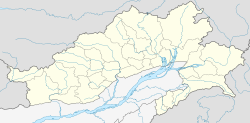Dong | |
|---|---|
Village | |
| Coordinates: 28°10′12″N97°2′30″E / 28.17000°N 97.04167°E | |
| Country | |
| State | Arunachal Pradesh |
| District | Anjaw district |
| Elevation | 1,240 m (4,070 ft) |
| Languages | |
| • Official | English |
| Time zone | UTC+05:30 (IST) |
| ISO 3166 code | IN-AR |
| Vehicle registration | AR |
Dong is a small village in the Dong valley of Anjaw district, Arunachal Pradesh, India. [1] It is one of the easternmost villages in India, near the point where India, China, and Myanmar border meet. It is the location of a peak, atop which tourists climb at 3 am to see the sunrise. It isn't the easternmost point of the country but it is one of the easternmost locations accessible by car. [2]

